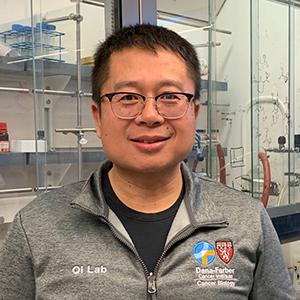Dissect the function of histone demethylase KDM5 on overcoming drug resistance toward immunotherapy in multiple myeloma

Jun Qi
PhDDana-Farber Cancer Institute
Project Term: October 1, 2022 - September 30, 2025
We identified that KDM5 can regulate important transcription factors in multiple myeloma (MM) and regulate the bone marrow (BM) microenvironment in providing protection toward MM, which also reduces anti-MM immunity. Thus, our study will utilize our novel potent and selective KDM5 inhibitor to fully dissect the interactions between MM cells, the BM microenvironment and the immune system in cellular and animal models to establish important mechanistic insights into MM.
Multiple myeloma (MM) is characterized by excess plasma cells in the bone marrow (BM), lytic bone lesions, and immunodeficiency and is associated with monoclonal proteins in the blood and/or urine. Despite many improvements in treatments for MM, MM is considered incurable and has a five-year overall survival rate of only 45%. Thus, there remains an urgent need for new therapies. Importantly, MM is protected by the BM microenvironment, which confers resistance to MM therapies. In MM, the BM microenvironment further impairs the anti-MM immune response, which reduces the ability of the immune system to eliminate MM cells, further increasing the challenge for MM treatment. As the BM microenvironment interacts with MM cells and the immune system in a complicated manner, the mechanism of this BM microenvironment interference remains unclear.
Our recent study suggests that MM as well as BM microenvironment mediated protection are regulated by inappropriately activated or silenced genes or important transcription factors through a different mechanism, called epigenetics. Among all the epigenetic proteins, we identified that one such epigenetic regulator, KDM5A, is overexpressed in MM and we developed a potent small molecule, JQKD82, that can effectively inhibit MM cell growth in cell culture media and in animal models. Importantly, JQKD82 can control a master transcription factor, MYC, in MM through KDM5 inhibition. The inhibitor can also overcome BM microenvironment induced protection of MM cells. Thus, utilizing our potent inhibitor together with genetic methods, we can build a clear picture of the interactions between MM cells, the BM microenvironment, and anti-tumor immunity controlled by KDM5. The mechanistic insight we establish will shed light on how to potentially overcome drug resistance in MM and sensitize MM cells toward an immune response. We will utilize our comprehensive cellular system and state-of-the-art animal model to elucidate an epigenetically regulated drug resistance mechanism in a setting close to real disease. Ultimately, our study can identify a mechanism to increase the efficiency of existing and novel targeted therapies for MM and improve patient outcomes.
Our team comprises a unique and wide spectrum of expertise required for studying the novel KDM5 regulated mechanism in MM. Dr. Qi is a chemical biologist who develops variety of novel inhibitors to target epigenetic proteins. Dr. Anderson is a physician scientist who dissects mechanisms of different targets and promotes novel therapy for MM patient treatment. By combining our expertise, this project is uniquely poised to: 1) derive unprecedented mechanistic insights of KDM functions within MM and 2) yield preclinical rationale for targeting KDM5 to conquer the challenge of drug resistance caused by the BM microenvironment’s protection. We anticipate that these studies will result in new therapeutic options, leading to significant improvements in MM outcomes.